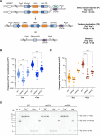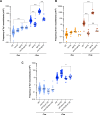The Slx4-Rad1-Rad10 nuclease differentially regulates deletions and duplications induced by a replication fork barrier
- PMID: 40446207
- PMCID: PMC12151478
- DOI: 10.1371/journal.pgen.1011720
The Slx4-Rad1-Rad10 nuclease differentially regulates deletions and duplications induced by a replication fork barrier
Abstract
Genome instability is a hallmark of cancer that can be caused by DNA replication stress. Copy number variation (CNV) is a type of genomic instability that has been associated with both tumorigenesis and drug resistance, but how these structural variants form in response to replication stress is not fully understood. Here, we established a direct repeat genetic reporter in Saccharomyces cerevisiae to detect recombination events that result in either a duplication or a deletion. Using this system, we measured recombination resulting from site-specific replication fork stalling initiated by Tus binding to an array of Ter sites. We found that a Tus/Ter fork block downstream of direct repeats induced CNV by a mechanism involving the Mph1 translocase, Exo1-catalyzed end resection and Rad51-dependent strand invasion. While the Slx4 scaffold protein and its nuclease-binding partner, Rad1-Rad10, were shown to be required for duplications, we found that they suppress deletion formation in this context. These opposing functions suggest that both recombination products arise through a large loop heteroduplex intermediate that is cleaved by Rad1-Rad10 in a manner that promotes duplications and eliminates deletions. Taken together, these studies give insight into the mechanisms governing CNV in the context of replication fork stalling, which may ultimately provide a better understanding of how replication stress contributes to cancer and other diseases characterized by genome instability.
Copyright: © 2025 Triplett et al. This is an open access article distributed under the terms of the Creative Commons Attribution License, which permits unrestricted use, distribution, and reproduction in any medium, provided the original author and source are credited.
Conflict of interest statement
The authors have declared that no competing interests exist
Figures







Similar articles
-
Mechanism for inverted-repeat recombination induced by a replication fork barrier.Nat Commun. 2022 Jan 10;13(1):32. doi: 10.1038/s41467-021-27443-w. Nat Commun. 2022. PMID: 35013185 Free PMC article.
-
Mutants defective in Rad1-Rad10-Slx4 exhibit a unique pattern of viability during mating-type switching in Saccharomyces cerevisiae.Genetics. 2008 Aug;179(4):1807-21. doi: 10.1534/genetics.108.090654. Epub 2008 Jun 24. Genetics. 2008. PMID: 18579504 Free PMC article.
-
Control of genome stability by SLX protein complexes.Biochem Soc Trans. 2009 Jun;37(Pt 3):495-510. doi: 10.1042/BST0370495. Biochem Soc Trans. 2009. PMID: 19442243
-
A postincision-deficient TFIIH causes replication fork breakage and uncovers alternative Rad51- or Pol32-mediated restart mechanisms.Mol Cell. 2010 Mar 12;37(5):690-701. doi: 10.1016/j.molcel.2010.02.008. Mol Cell. 2010. PMID: 20227372
-
Orchestrating the nucleases involved in DNA interstrand cross-link (ICL) repair.Cell Cycle. 2011 Dec 1;10(23):3999-4008. doi: 10.4161/cc.10.23.18385. Epub 2011 Dec 1. Cell Cycle. 2011. PMID: 22101340 Free PMC article. Review.
References
MeSH terms
Substances
Grants and funding
LinkOut - more resources
Full Text Sources
Research Materials

